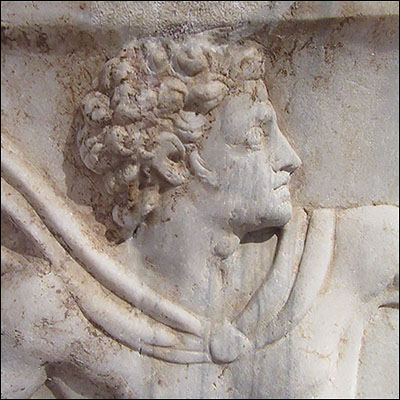
Ieson was the son of Alkimede and Aeson and the great-grandson of Minyas. Circa 2000 BCE Minyas founded a culture so distinct and prosperous it was called the Minyan Culture ... the major centers of the Minyan Culture were Orkhomenos and Iolkos in what would become known as Thessaly. Iolkos was located on the western slopes of Mount Pelion near the coast of the Gulf of Pagasai ... Orkhomenos was located in central Boeotia.
The life of Ieson was defined by two interconnected events: 1) the Quest for the Golden Fleece and 2) the love of the sorceress, Medeia. Ieson's life was heroic and glorious but his death was pitiable.
If the kingship of Iolkos had evolved naturally, the throne would have gone from Minyas to Kretheus to Aeson to Ieson. A problem arose when Kretheus's wife Tyro, Ieson's grandmother, became the consort of the god Poseidon ... Pelias was the son of Tyro and Poseidon, and thus the half-brother of Ieson's father, Aeson.
Pelias was arrogant and presumptuous ... as a son of Poseidon, he had no doubt about his superiority over Aeson ... when Kretheus died, Pelias took the throne. Even though Ieson was only an infant at the time, Aeson had the foresight to realize that Pelias would eventually consider Ieson a threat to his throne. For Ieson's protection and education, Aeson put him in the care of the Centaur Kheiron who lived on nearby Mount Pelion. Like all a Centaurs, Kheiron had the body of a horse with the torso and head of a man. Kheiron was renowned for his ability to bring out the best in his students ... he had tutored Herakles and would later be the instructor of the hero, Achilles. Ieson remained with Kheiron until he was old enough to return to Iolkos and confront his uncle Pelias.
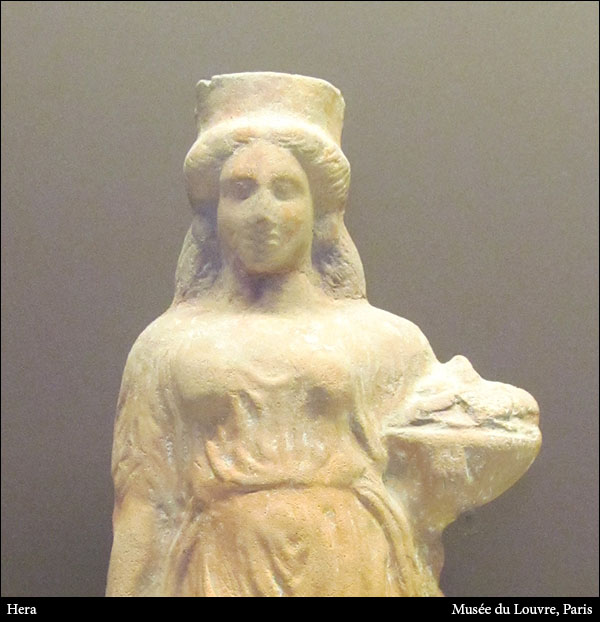
In order to reach Iolkos, Ieson had to cross the Anauros River, which runs from Mount Pelion to the Gulf of Pagasai. The goddess Hera, on one of her frequent excursions into the world of mortal humans, disguised herself as an old woman and waited for Ieson on the banks of the Anauros. When she saw Ieson coming, Hera pretended to be floundering in the surging river ... Ieson was young and strong ... he jumped into the water and saved the "old woman" from what he thought was certain death ... his chivalry was genuine and his motives were noble ... he had passed Hera's test. While struggling in the river, Ieson lost one of his sandals in the mire ... he gave this little thought at the time, but the lost sandal would become crucial when he reached Iolkos.
King Pelias was the undisputed ruler of Iolkos when Ieson arrived ... he and Queen Anaxibia had been blessed with a son and three daughters ... Akastos, Alkestis, Amphinome, and Euadne.
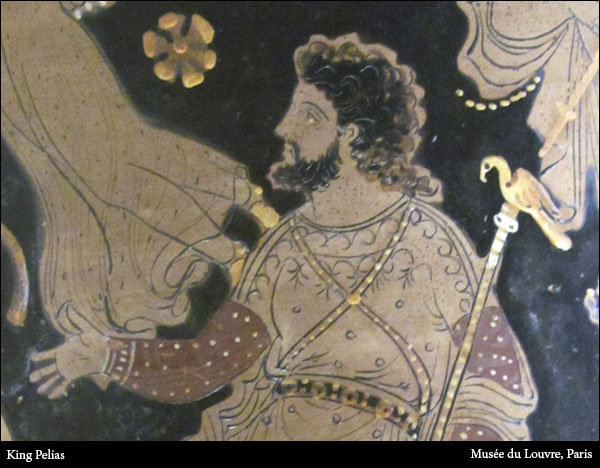
Pelias was a pious man in many ways but he was also arrogant in thinking he could thwart the will of the Immortals ... he had been given an oracle warning that a hateful doom awaited him ... the oracle foretold that he would be slain at the prompting of a man who would come to Iolkos wearing one sandal. Pelias ignored the oracle and planned to rule Iolkos until he died. Unbeknownst to Pelias, his desire to rule until his death and the oracle predicting his demise would both come true ... simultaneously.
Although Pelias was respectful of his father Poseidon and the other Immortals, he paid no honor to Pelasgian Hera. She received the surname "Pelasgian" because she was the protector of the ancient people of the Aigean Sea ... this appellation went back fifteen hundred years before Pelias's time ... for him to neglect Hera not only jeopardized his own wellbeing, it put the citizens of Iolkos at risk of Hera's righteous retribution.
Pelias was presiding over a ceremony to honor Poseidon when Ieson entered the city ... he recognized Ieson immediately and knew that Aeson's son had returned to claim his birthright ... Pelias also noted that Ieson was only wearing one sandal. He decided that the best way to dispose of Ieson would be to send him on a seemingly hopeless quest. Pelias commanded Ieson to retrieve the Golden Fleece from King Aietes in the far-off land of Kolkhis. He promised to relinquish the throne of Iolkos to Ieson when he returned with the fleece. Pelias knew that King Aietes would never surrender the Golden Fleece willingly and if Ieson survived the dangerous sea voyage to Kolkhis, he would undoubtedly be killed by Aietes when he arrived.
Ieson accepted the challenge and began making preparations for the trip ... he needed a ship and a crew.
In order to sail to Kolkhis at the eastern edge of the Black Sea, Ieson needed a ship ... a ship with a subtle blend of the practical and the supernatural ... the Argo became the perfect vessel for the quest.
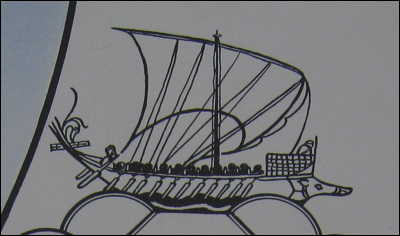
The Argo was the most famous ship to ever sail the ancient seas. The name chosen for the ship had two possible origins. The shipwright responsible for the actual construction was named Argos but the name Argo can be literally translated as Swift ... clever wordplay for the name of an extraordinary ship. The Argo was built circa 1285 BCE.
The Argo was assembled by Argos, but the inspiration and guidance came from the goddess Athene. The Argo was constructed on the Gulf of Pagasai near Iolkos. Special wood was hewn for the ship on nearby Mount Pelion and for that reason it is often referred to as Pelian Argo. Athene provided the beam of the ship, which was set in the center of the stem ... it was made of Dodonian oak ... Dodona was the site of the oldest Oracle of Zeus in Greece. When the Argonauts were in danger of being destroyed by Zeus, Hera used the Dodonian stem to speak to the Argonauts Kastor and Polydeukes and warn them of their peril.
After the Quest for the Golden Fleece was over, Ieson took the noble craft to the Isthmus of Korinth and dedicated it to the lord of the sea, Poseidon.
While the Argo was being built, Ieson let it be known that he needed a crew of the bravest men in Greece to accompany him on an adventure of a lifetime. The men who responded were indeed the best men in Greece ... they were kings, princes, and demigods. The crewmen were called Argonauts, i.e. Argo Seamen. The Argonauts included sons of Zeus as well as sons of Poseidon, sons of Boreas (North Wind) and sons of Helios (Sun).
The Argonauts (an alphabetical list)
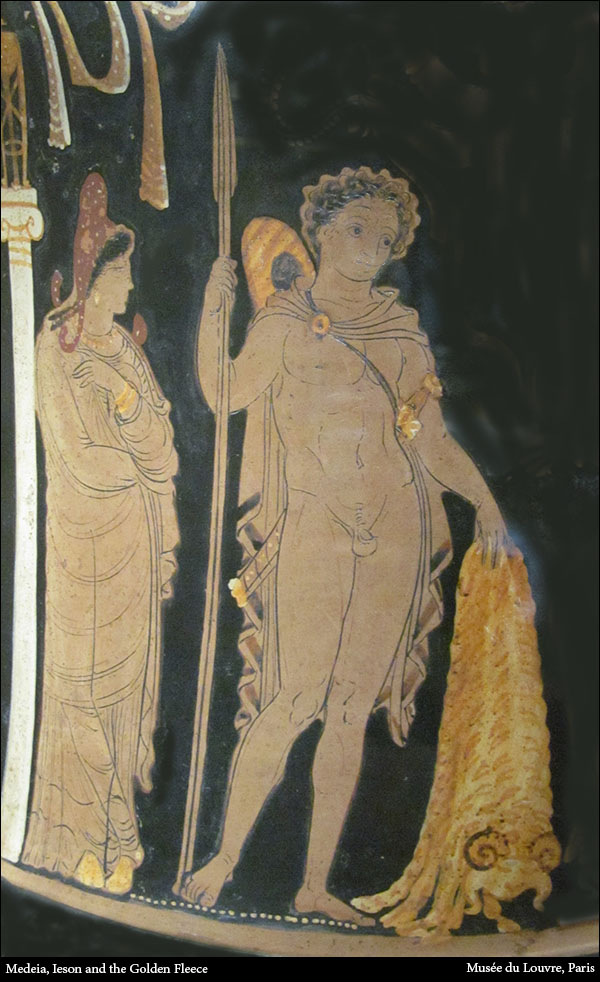
A ram with a Golden Fleece was created by Hermes and Nephele ... Hermes was the messenger of the Immortals and Nephele was a 'cloud woman' created by Zeus.
Nephele was the wife of King Athamas of Orkhomenos ... they had two children—Phrixus and Helle. Athamas abandoned Nephele and took a new wife named Ino ... Phrixus and Helle fled Orkhomenos when Ino began plotting against them. To help Phrixus and Helle escape their dangerous situation, Hermes and Nephele crated a flying ram with a Golden Fleece to carry them away. As they flew from Europe to Asia, Helle fell from the back of the ram and drowned in the sea ... the narrow straits where she drowned was named Hellespont (Helle's Sea). Phrixus flew on to Kolkhis at the eastern edge of the Black Sea.
Phrixus arrived safely at Kolkhis and was welcomed by King Aietes ... the king did not miss the significance of the flying ram and the good fortune it might bring to his kingdom. He welcomed Phrixus into his household ... he arranged for Phrixus to marry his daughter Khalkiope without payment of the customary dowry.
The divinely created ram had only one purpose and once Phrixus had been delivered safely to Kolkhis, its mission had been accomplished. The ram asked to be sacrificially killed ... Phrixus complied ... he sacrificed the ram to Zeus, god of fugitives, and then placed the ram's Golden Fleece in the Grove of Ares where it was thereafter guarded by an ever-vigilant dragon.
Phrixus and Khalkiope had four sons—Argos, Kytissoros, Melas, and Phrontis. Prior to his death, Phrixus instructed his sons to go to Orkhomenos and "take the possessions" of his despicable father, King Athamas.
Argos, Kytissoros, Melas, and Phrontis obeyed their fathers' instructions and sailed westward across the Black Sea towards Greece. A storm blew their ship ashore on the Island of Ares where they remained until they were rescued by Ieson and the Argonauts. The fact that the sons of Phrixus were saved by the Argonauts was of course no accident ... one of the Immortals (probably Hera) was looking out for the young men. After their rescue, they became part of the crew of the Argo.
The story of the Quest for the Golden Fleece was eloquently told by Apollonius of Rhodes in his epic poem, Argonautika.
With the blessing of Apollon, Ieson and the Argonauts launched the Argo amid celebrations and solemn rites. Apollon was an active protector of the Argonauts ... he gave Ieson three tripods from the temple at Delphi to help guarantee a safe homecoming. A son of Apollon named Idmon was one of the Argonauts ... before the Argo sailed, he made two important prophecies: 1) Ieson would be successful in retrieving the Golden Fleece and 2) he (Idmon) would die before the Quest was complete.
The first stop for the Argo was the island of Lemnos. The Argonauts were welcomed on the island because the women of Lemnos had staged a revolt and killed their husbands ... they were eager to have male companions again. The men of Lemnos had disgraced their wives, so their murders were somewhat justified.
The Argonauts arrived a year after the women's revolt. King Thoas was not murdered like the other men ... he fled Lemnos and his daughter Hypsipyle became queen. She fell in love with Ieson and offered him the throne of Lemnos ... he refused but stayed on Lemnos long enough for Hypsipyle to have twin sons by him. When it came time for the Argonauts to leave, Hypsipyle gave Ieson a crimson robe made by the Kharites (Graces) for the god Dionysos. The robe eventually became the property of King Thoas ... he gave it to Hypsipyle.
The land of Kolkhis was on the eastern edge of the Pontos (Black Sea) ... the Argonauts sailed north through the Aigean Sea to the Hellespont and onwards to the Propontis (Sea of Marmara) and survived the attacks of several of the native inhabitants. They encountered the pitiful blind seer Phineus, who was being punished by Zeus and Helios (Sun) by having his food eaten and defiled by two flying women, the Harpies. The winged sons of Boreas—Kalais and Zetes—took pity on Phineus and chased away the Harpies, freeing Phineus from his curse. Phineus rewarded the Argonauts by giving them instructions as to how to get to Kolkhis and then safely return to their homeland.
The journey to Kolkhis required the Argonauts to pass between the Clashing Rocks that guarded the narrow passage from the Propontis to the Pontos (Black Sea). Called "the twin Kyanean Rocks where the two seas meet," the gigantic rocks would clash together whenever any living thing tried to pass between them. Phineus told the Argonauts to send a dove through the Clashing Rocks before they attempted the passage with the Argo. He said that if the dove survived, it would be safe for them to proceed.
The Argonauts approached the narrow channel between the Clashing Rocks and released a dove as Phineus suggested ... when the dove made it through with only the loss of its tail feathers, the Argo sailed boldly into the passage. The goddess Athene held back one of the rocks with one hand and pushed the Argo through with the other. The Clashing Rocks then became stationary islands and never menaced sailors again.
Traversing the Black Sea, the Argonauts came to the desert island Thynias at twilight. As they mounted the shore, Apollon passed overhead as he traveled from Lykia to the northern land of the Hyperboreans. They clearly saw his golden hair as well as his bow and quiver ... as he passed, the island quaked, and the waves surged. The Argonaut Orpheus suggested that they call the island the Sacred Isle of Apollon of the Dawn ... an alter was built and Apollon provided suitable animals for the sacrifice and feast ... the Argonauts danced and sang in honor of Apollon, Lord of Dawn.
The Argo lost its first crewmen in the land of the Mysians. Hylas, the young squire of Herakles, went into the forest to search for drinking water. As he knelt by a spring, a water Nymph saw Hylas and found him literally irresistible ... she pulled him into the water and he never emerged. Herakles and the Argonaut Polyphemos searched frantically for Hylas but never found him. They refused to leave the island without Hylas ... the Argo sailed without Hylas, Herakles or Polyphemos.
The fate of the Argonauts began to change, and they suffered their first casualties ... Idmon, the seer son of Apollon, was the first to die ... he died from wounds inflicted by a monstrous, white-tusked boar. Next, the helmsman Tiphys died of a fast-acting sickness. When they came to the Island of Ares, Oileus was wounded in the shoulder when he was struck by an arrow-like feather from one of the war-birds guarding the island. Repelling the war-birds, the Argonauts landed on the Island of Ares and were surprised to find four young men who had been stranded on the island after a storm ripped their ship to pieces.
The young men on the island were the four sons of Phrixus and Princess Khalkiope ... Phrixus had originally ridden the ram with the Golden Fleece to Kolkhis and sacrificed it in the Grove of Ares ... Phrixus's sons had been on their way Orkhomenos to seek retribution for their grandfather's ill treatment of their father. Ieson persuaded them to join the Argonauts.
Arriving at Kolkhis, Ieson was unsure as to how he should approach King Aietes, but the goddesses Hera and Athene helped facilitate the meeting. First of all, the goddesses asked Aphrodite, goddess of love, to persuade Eros (the primal god of love) to shoot Aietes's daughter, Princess Medeia, with an arrow of love, making her hopelessly attracted to Ieson. With Medeia's compliance assured, Hera put a mist around Ieson so he could get to Aietes's palace without being seen.
Hera lifted the mist from Ieson, and he seemed to appear out of thin air in front of Aietes's throne. Normally, Princess Medeia would have been in the temple of Hekate where she was a priestess, but Hera induced her to be in attendance when Ieson approached the king. It was then that Eros shot Medeia with the golden arrow of irresistible love for Ieson.
Aietes was not surprised when Ieson boldly announced that he wanted the Golden Fleece. The king decided that since Ieson obviously had divine protection, it would not be wise to blatantly refuse his request. Aietes cunningly challenged Ieson to demonstrate his strength and prove his worthiness.
King Aietes had some of the dragon's teeth that Kadmos had used to populate his newly founded city of Thebes ... Aietes also had two supernatural, bronze-footed bulls that snorted fire ... he wanted Ieson to harness the bulls, plow a field and then plant the dragon's teeth ... from the teeth would grow a crop of Earth-Born warriors ... Ieson would have to fight and kill the warriors in order to claim the Golden Fleece.
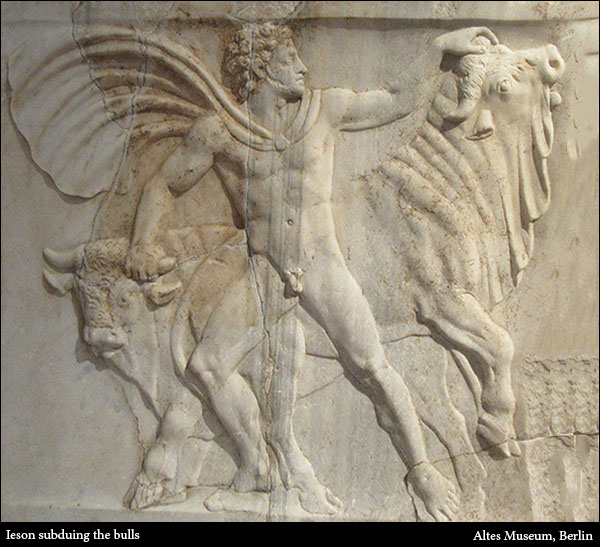
Princess Medeia was a priestess of Hekate and the niece of the goddess Kirke (Circe) ... she thereby acquired an intimate knowledge of drugs and spells. In preparation for Ieson's upcoming ordeal, Medeia plucked flowers that were growing on the nearby Caucasus Mountains for a special potion. The god Prometheus had been chained to the mountain for defying Zeus ... as part of the punishment, an eagle ripped at Prometheus's flesh ... Prometheus's immortal blood nourished the flowers Medeia needed for her potion.
Medeia prepared the potion and met with Ieson without her father's knowledge ... the potion would protect Ieson in the upcoming ordeal. Following Medeia's instructions, Ieson made a sacrifice to Hekate and bathed himself and his weapons in the magic potion.
At dawn the following day Ieson went into the field to face the bronze-footed bulls and plant the dragon's teeth. In order to prepare the field, Ieson had to harness the bulls with bronze yokes and then use a one-piece plow made of "unbending adamant."
The fire-breathing bulls charged at Ieson as soon as he entered the field ... his potion-coated shield protected him from the flames and allowed him to get close enough to knock the bulls to their knees. The Argonauts Kastor and Polydeukes helped secure the yokes around the bull's necks and attach the plow.
Ieson plowed the farrows with the subdued bulls and planted the dragon's teeth... the Earth-Born warriors sprang from the ground and attacked Ieson with fury. Using the same trick Kadmos used when he fought the Earth-Born warriors at Thebes, Ieson tossed a stone in their midst and let them fight amongst themselves until their numbers were small enough for him to kill the remainder. Aietes was furious.
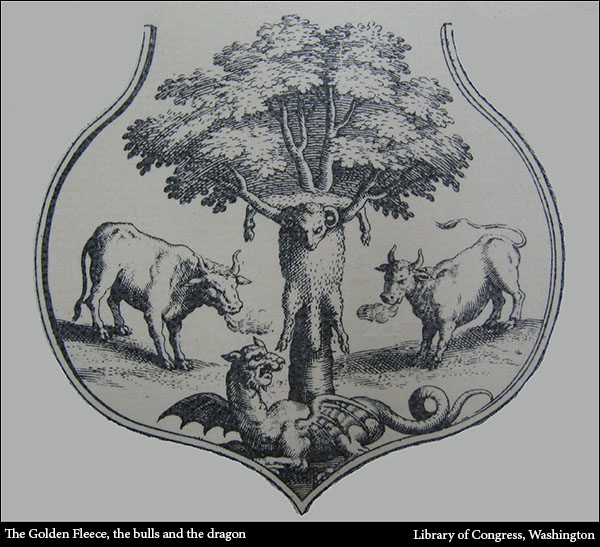
Medeia, still in the thralls of love, led the Argonauts to the Grove of Ares where the Golden Fleece was kept. The fleece was protected by an ever-vigilant dragon but Medeia cast a spell on the dragon with a hypnotic song and undiluted potions. As the dragon swooned, Ieson took the fleece ... he, Medeia, and the Argonauts fled Kolkhis with the king's troops at their heels.
Aietes insisted that he would have honored his promise to Ieson and given him the Golden Fleece but now that Ieson had stolen the Golden Fleece and his daughter, the king felt fully justified in sending his navy to forcefully bring them back.
Hoping to elude their pursuers, the Argonauts took the long and difficult route up the Ister River (the Danube) and across southern Europe. Aietes's son, Apsyrtos, led the Kolkhian fleet. When the Argonauts were finally cornered and feared a direct confrontation with Apsyrtos and his overwhelming number of ships, Ieson and Medeia devised a treacherous plan whereby they would meet with Apsyrtos and kill him.
Medeia made arrangements to meet Apsyrtos at a temple of Artemis on a secluded island. She chose the sacred temple to distract Apsyrtos from the treachery that was to follow. Gifts, including the crimson robe Ieson received from Queen Hypsipyle, were promised to Apsyrtos if he would to come alone to negotiate Medeia's surrender. Apsyrtos agreed to the terms and took one ship to the island ... he left the crew onboard and went alone to meet Medeia.
Darkness concealed Ieson as he watched Medeia maneuver Apsyrtos into a vulnerable position. Ieson attacked Apsyrtos with brutal determination ... he fell to the temple floor and bled to death. Ieson chopped off Apsyrtos's arms and legs and then tasted Apsyrtos's blood three times as was customary to atone for a treacherous murder.
The Argonauts ambushed the men who accompanied Apsyrtos the island ... all were killed. The remainder of the Kolkhians escaped unharmed but without a leader, they lost their momentum and the Argonauts escaped. Fearful of what King Aietes would do when he learned of the death of Apsyrtos, the sailors decided that if they could not capture Medeia they would stay in Europe and never return to Kolkhis.
Zeus was furious about the murder of Apsyrtos and intended to severely punish Ieson for such cowardly behavior. In an effort to protect Ieson and the Argonauts, Hera used the keel of the Argo, which had been crafted by Athene, to warn them ... she urged them to go to the goddess Kirke and beg for atonement.
Prior to the arrival of Ieson and Medeia, Kirke had been troubled by nightmares in which the walls of her palace dripped blood ... flames consumed the drugs she used to bewitch strangers. She was bathing in seawater trying to wash away the aftereffects of the troubling dream when she became aware that a ship had landed on her island and a group of men accompanied by a maiden were approaching. Using a charmed hand-gesture, Kirke motioned for the Argonauts to follow her but Ieson ordered them to wait while he and Medeia followed Kirke to her palace. The goddess was slightly amazed to see that only Ieson and Medeia had obeyed her ... she asked them sit on a polished bench but they went to the hearth and assumed the posture of supplicants ... Ieson looked at the floor and Medeia hid her face in her hands.
Kirke immediately realized that her guests were guilty of murder. However, in reverence for Zeus, the god of supplicants, she began to offer the proper sacrifice to cleanse them of their guilt. She held a sow that had recently given birth above their heads and severed its neck ... she sprinkled their hands with blood. Next Kirke made propitiation with drink-offerings while she called upon Zeus the Cleanser, the protector of murder-stained supplicants ... Kirke burned atonement cakes without wine and prayed that the Furies and Zeus would forgive her guests for the crimes they had committed.
After the rituals were completed, Kirke invited Ieson and Medeia to sit on a bench facing her ... she asked them to clearly state the series of events that had brought them to her island as supplicants. When Medeia looked directly at Kirke, the goddess knew without doubt that the maiden was of the race of Helios and one of her kin ... a golden light shone from Medeia's eyes that clearly showed her heritage. Medeia began telling her aunt Kirke about the adventures and travels she and Ieson had endured but she carefully did not mention the murder of Apsyrtos ... Kirke knew Medeia was not being completely honest and yet still pitied the young girl.
Kirke pondered the situation and told Medeia that King Aietes, Kirke's brother and Medeia's father, would soon exact a heavy wrath for the murder of his son ... she told Medeia that she would not add to her and Ieson's troubles by inflicting more suffering upon them but she was adamant that they leave her island at once and endure whatever fate Zeus and the other Immortals were sure to mete out.
The goddess Hera enlisted other Immortals help Ieson and Medeia. Hera implored Thetis to gather her sisters, the Nereids, to swim beside the Argo when it sailed between the forbidding Planktae, also known as the Wandering Rocks or the Rovers ... she asked her son Hephaistos to quite his hammers when the Argo sailed past his forge ... she asked Aeolus (lord of the winds) to give the Argo a favorable breeze. One by one—the Planktae, the six-headed Skylla, the whirlpool Kharybdis, the clear-voiced Sirens—all obstacles were successfully negotiated by the Argonauts.
Skheria, the island of Phaiakians, presented new problems for Ieson and Medeia. They thought they had eluded King Aietes's pursuers ... they had not. Kolkhian ships arrived and demanded that Medeia be surrendered to them. King Alkinoos and Queen Arete of the Phaiakians wanted to give sanctuary to the fugitives but moral law dictated that an unmarried woman had to obey her father. Queen Arete provided an equitable solution ... she suggested that Ieson marry Medeia, thus negating any daughter-father obligations.
Ieson and Medeia had intended to marry when they returned to Iolkos so Queen Arete's suggestion only hastened the inevitable. Besides, Ieson did not want to be hounded by Aietes's soldiers any longer. The marriage ceremony was elegant and took on a fairytale quality when the Golden Fleece was used to adorn the marriage-bed. All classes of Phaiakians were in attendance as well as the Nymphs of the island. The Kolkhians were forced to withdraw ... King Aietes no longer had authority over his daughter.
Calamity struck as soon as the Argonauts left Skheria ... the Argo was caught in a tempest and blown to the shores of Libya—the northern coast of Africa west of Egypt. The storm pushed the Argo deep into a temporary inlet and then the water withdrew, leaving the ship and crew stranded in the desert. With great difficulty, the Argonauts began to carry the Argo across the desert in an attempt to find the sea. Two Argonauts perished in the desert—Mopsos died from a snakebite and Kanthos was killed while stealing sheep.
During a moment that might have been a divine hallucination, the Argonauts saw the goddesses known as the Hesperides ... they told the Argonauts of their encounter with Herakles and how he killed the guardian dragon and took their Golden Apples. They showed the Argonauts the spring Herakles created while he was passing through Libya. Apparently, Herakles simply kicked a rock and fresh water poured onto the desert sands. The grateful Argonauts drank their fill before continuing through the inhospitable terrain.
The seemingly endless trek through Libya continued until they reached the shores of Lake Trito. The god Triton arose from the waters of the lake to examine the trespassers. Ieson presented Triton with one of the tripods Apollon had given him at the beginning of the Quest ... Triton was pleased with the gift as well as the respect shown by Ieson. Triton reciprocated by giving the Argonaut Euphemos a clod of dirt that he would later throw into the sea and create the island of Kalliste. Triton then escorted the Argonauts to the Mediterranean Sea.
Approaching the island of Krete, the Argonauts were unable to make a safe landing because Talos, a gigantic bronze man, guarded the shore. Medeia used her magical powers to save the Argo from certain destruction. She invoked Death-Spirits to befuddle Talos and in a fit of confusion, the bronze giant stumbled on the rocky shore and tore the thin membrane at his heel allowing the fluid of life to drain from his otherwise impervious body.
The island of Krete was merely a stopover before the final leg of their journey. Sailing north from Krete, the Argo sailed into a very dense fog ... not an ordinary fog that sailors normally encounter but one of supernatural density. All seemed lost until Apollon emitted a light penetrating the fog ... following the light, the Argo came to an otherwise unseen island ... the Argonauts named the island Anaphe, which might be loosely translated as gleam or glimmer.
From Anaphe the surviving Argonauts sailed safely to their homes, thus ending the voyage of the Argo according to Apollonius of Rhodes. The continuation of the story was told by poets such as Euripides, historians such as Diodorus of Sicily and in various pieces of artwork dating back to the fifth century BCE.
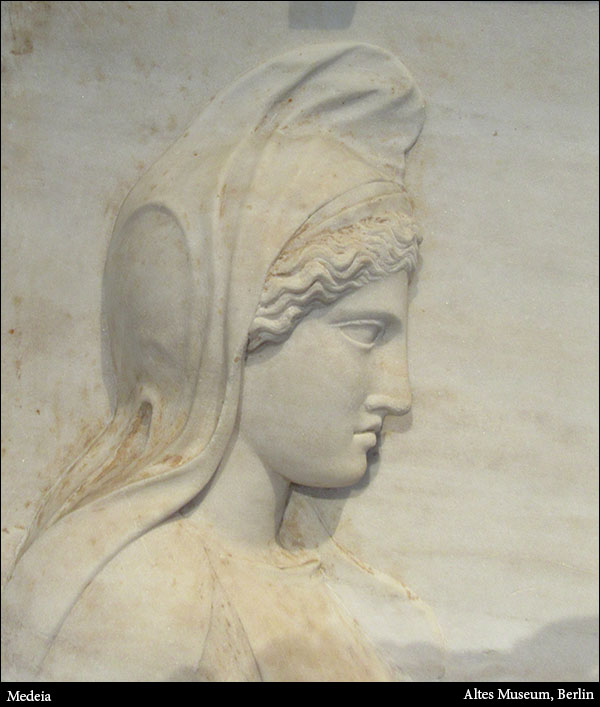
Before the Argo reached Iolkos, a rumor was circulated saying that Ieson and the Argonauts had perished at sea. Aeson truly believed his son was dead and King Pelias used that false belief to exploit Aeson's venerability ... he forced the desperate man to drink a fatal quantity of ox blood ... to complete the elimination of Aeson's relatives, Pelias murdered Ieson's younger brother Promakhos.
When Ieson, Medeia, and the Argonauts reached Iolkos they camped outside the city ... Ieson knew Pelias was responsible for his father's death and wanted revenge. Taking the city by force seemed unrealistic ... he had too few men to storm the city and it would take too long to assemble a suitably sized army. Medeia said she could get them inside the city without a fight if they would let her enter the city alone ... after all, she helped them steal the Golden Fleece and kill the bronze giant Talos ... she was very resourceful and there was every reason for the Argonauts to trust her.
Medeia said she had drugs "of marvelous potency" that she had never used on humans before ... the drugs were given to her by the Roaring Goddess Hekate and the Dread Goddess Kirke. Medeia said she would use her drugs on Pelias and his daughters, and then give the Argonauts a signal when it was safe for them to enter the city ... smoke by day or fire by night.
Medeia ingested a special potion she concocted to make her unrecognizable ... her hair turned gray and her skin took on the appearance of extreme age. She entered the city carrying a hollow statue of Artemis ... the hollowed-out statue was used to hide the drugs she intended to use on Pelias and his daughters. She made a stupendous entrance ... the people were dazzled and more than a little frightened. Medeia declared that she was sent by Artemis and no one doubted her.
She continued her "inspired" performance for Pelias and his daughters ... they were terrified ... she convinced them that Artemis was actually there in person to bring prosperity to the house of the king. She told them that the goddess had been flying over the earth in a chariot drawn by dragons seeking the most pious king in all the world so she could establish a place of worship. The goddess had commanded that Pelias be given that honor and furthermore, Medeia told Pelias that the goddess would restore his youthful vigor.
Pelias was amazed but seemed to be hesitant ... Medeia asked for some pure water and retired to a hidden chamber ... as she washed herself, the effects of the aging potion were rinsed away ... she emerged from the chamber as the youthful princess she really was. To further prove that Artemis was the source of her powers, Medeia caused the illusion of dragons to appear in the sky. Pelias was thoroughly convinced that what he was seeing was real and that the goddess Artemis was indeed present in his kingdom and speaking through this strange woman. In a private conversation with Pelias, Medeia told him to instruct his daughters to do whatever she commanded. She told him that the deeds that needed to be done would have to be performed by his daughters and not by his servants ... he did as she instructed and the girls willingly agreed.
After Pelias had fallen asleep, Medeia went to Alkestis, Amphinome, and Euadne ... she informed the maidens that in order to restore their father's youth, it would be necessary to dismember him. The girls became hostile at the suggestion that they harm their father. Medeia again used her drugs to achieve the necessary delusion ... she hacked up an aged ram, pretended to place the pieces in a caldron and by sleight of hand pulled a lamb from the pot. The younger daughters were convinced but Alkestis refused to participate in the mutilation of her father.
Medeia took no part in the dismemberment of Pelias ... his daughters, Amphinome and Euadne, willingly performed the gruesome task ... they hacked up their father's body and placed the pieces in a caldron. When the ghastly chore was finished, Medeia told the girls that she needed to be alone so she could pray to the moon ... she sent them to the highest roof of the palace with lamps ... the girls unknowingly gave the Argonauts the signal to attack the city.
Ieson was magnanimous when he entered the city. He convinced the daughters of Pelias that they did not deserve to die for their abominable actions ... he convinced them that they were not to blame for their father's death. At an assembly of the people of Iolkos, Ieson justified the murder of Pelias as a fitting punishment for the wrongs he had committed against his (Ieson's) family. He willingly gave over the kingdom to Pelias's son Akastos and arranged suitable marriages for Pelias's daughters.
It is not stated implicitly but we are led to believe that Ieson and Medeia were forced to leave Iolkos because the people feared Medeia's sorcery. After stopping at the Isthmus of Korinth to dedicate the Argo to Poseidon, Ieson and Medeia accepted the hospitality of King Kreon of Korinth.
Ieson and Medeia seemed to be making a permanent home at Korinth ... after ten years they were on good relations with King Kreon and had three sons: Thessalus, Alkimenes and Tisandrus ... Thessalus and Alkimenes were twins ... Tisandrus was much younger than his brothers.
Ieson became infatuated with King Kreon's daughter Glauke and decided to marry her. There are various reasons given for Ieson's dismissal of Medeia but they all seem a bit contrived. The historian Diodorus of Sicily blamed Medeia for Ieson's infidelity because she was getting old and no longer attractive ... the playwright Euripides believed that Medeia was to blame because she didn't understand that Ieson was only trying to secure a better future for his sons by marrying the king's daughter. Placing the blame on Medeia seems unjust ... she appears to have been a loyal wife and good mother but Ieson, for whatever reason, decided to discard her and marry Glauke.
Regardless of why Ieson wanted to divorce Medeia, his decision had disastrous results. Medeia was a sorceress of the highest order ... she clearly had the ability to achieve monstrous deeds and had saved Ieson and the Argonauts on several occasions with spells and potions that would make anyone fearful. Ieson however must have thought he was immune from any sort of retaliation from his wife. He was very wrong ... Medeia's fury was fast and potent ... she began by killing Glauke.
Medeia used her magical skills to devise an acid-like poison ... she saturated a cape with the poison and, according to some versions of the story, used one of her sons to deliver it to Glauke as a wedding gift. When Glauke put the cape on, she was literally set afire ... when her father tried to save her, he too was burned. Glauke ran from the palace and threw herself into a well and died.
The murder of Glauke was just the first step on the road to Medeia's madness. Her next outrage was the murder of two of her children ... Thessalus somehow survived. Nothing can be said to justify or understand such an outrageous act.
With everyone in Korinth out for her blood, Medeia conjured a chariot pulled by dragons and fled ... in this instance, the dragons were not a delusion caused by spells and potions ... she fled Korinth on a chariot pulled by dragons. She was welcomed in Athens and, using her charms and enchantments, seduced and married King Aigeus ... they had one son, Medus. Apparently, there was a conflict between Medeia and Theseus, King Aigeus's son by his consort Aithre ... Medeia and Medus relocated to Asia Minor where he subsequently founded the nation of the Medes.
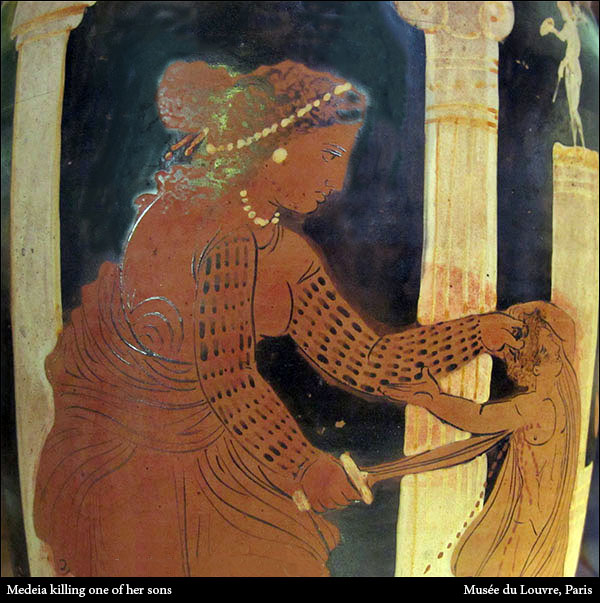
After the death of Princess Glauke and Ieson's children, the Korinthians sent an envoy to Delphi to ask Apollon what should be done with the bodies of the children ... the god replied that the boys should be buried in the sanctuary of Hera and honored as heroes.
According to some historians, the Korinthians blamed Ieson for the entire tragedy. It's assumed that because of his personal grief and the disgrace of being publicly ostracized, Ieson became despondent and killed himself. A more poetic version of the story was told by Euripides ... he suggested that Ieson's death was accidental ... the Argo had not been used for over ten years and was rotting at the Isthmus of Korinth where it had been left after the Quest for the Golden Fleece ... Ieson was sleeping under the decks of the Argo and was crushed by falling rotten timbers.
Perhaps twenty years after Ieson and Medeia left Iolkos, their son Thessalus returned to become king. Ieson had left the kingship of Iolkos to Akastos, a former Argonaut and Pelias's son. Thessalus returned to Iolkos just after Akastos died ... being of the proper bloodline, Thessalus became the new king ... his name was adapted to all people of that region ... they became Thessalians.
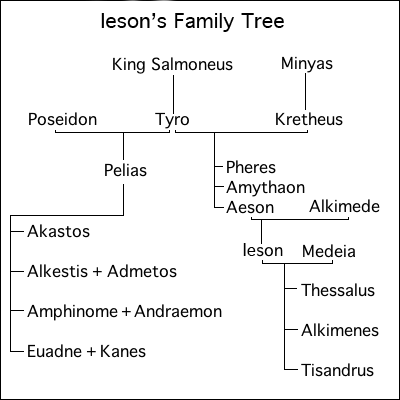
The Argonautika by Apollonius of Rhodes
The Iliad
The Odyssey
Theogony
Catalogues of Women and Eoiae
Catalogue of Women
The Histories by Herodotos
Library of History by Diodorus of Sicily
Description of Greece by Pausanias